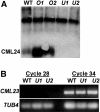CML24, regulated in expression by diverse stimuli, encodes a potential Ca2+ sensor that functions in responses to abscisic acid, daylength, and ion stress
- PMID: 16113225
- PMCID: PMC1203374
- DOI: 10.1104/pp.105.062612
CML24, regulated in expression by diverse stimuli, encodes a potential Ca2+ sensor that functions in responses to abscisic acid, daylength, and ion stress
Abstract
Changes in intracellular calcium (Ca(2+)) levels serve to signal responses to diverse stimuli. Ca(2+) signals are likely perceived through proteins that bind Ca(2+), undergo conformation changes following Ca(2+) binding, and interact with target proteins. The 50-member calmodulin-like (CML) Arabidopsis (Arabidopsis thaliana) family encodes proteins containing the predicted Ca(2+)-binding EF-hand motif. The functions of virtually all these proteins are unknown. CML24, also known as TCH2, shares over 40% amino acid sequence identity with calmodulin, has four EF hands, and undergoes Ca(2+)-dependent changes in hydrophobic interaction chromatography and migration rate through denaturing gel electrophoresis, indicating that CML24 binds Ca(2+) and, as a consequence, undergoes conformational changes. CML24 expression occurs in all major organs, and transcript levels are increased from 2- to 15-fold in plants subjected to touch, darkness, heat, cold, hydrogen peroxide, abscisic acid (ABA), and indole-3-acetic acid. However, CML24 protein accumulation changes were not detectable. The putative CML24 regulatory region confers reporter expression at sites of predicted mechanical stress; in regions undergoing growth; in vascular tissues and various floral organs; and in stomata, trichomes, and hydathodes. CML24-underexpressing transgenics are resistant to ABA inhibition of germination and seedling growth, are defective in long-day induction of flowering, and have enhanced tolerance to CoCl(2), molybdic acid, ZnSO(4), and MgCl(2). MgCl(2) tolerance is not due to reduced uptake or to elevated Ca(2+) accumulation. Together, these data present evidence that CML24, a gene expressed in diverse organs and responsive to diverse stimuli, encodes a potential Ca(2+) sensor that may function to enable responses to ABA, daylength, and presence of various salts.
Figures







References
-
- Arora A, Sairam RK, Srivastava GC (2002) Oxidative stress and antioxidative system in plants. Curr Sci 82: 1227–1238
-
- Bagnall DJ (1993) Light quality and vernalization interact in controlling late flowering in Arabidopsis ecotypes and mutants. Ann Bot (Lond) 71: 75–83
-
- Bechtold N, Ellis J, Pelletier G (1993) In planta Agrobacterium mediated gene transfer by infiltration of adult Arabidopsis thaliana plants. CR Acad Sci Paris Life Sci 316: 1194–1199
Publication types
MeSH terms
Substances
Associated data
- Actions
- Actions
- Actions
- Actions
- Actions
Grants and funding
LinkOut - more resources
Full Text Sources
Molecular Biology Databases
Miscellaneous

